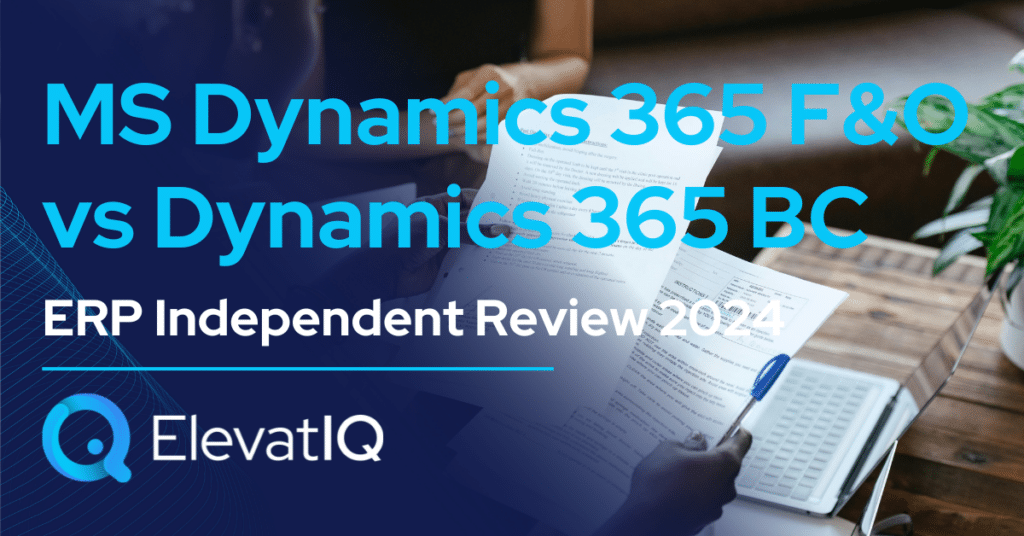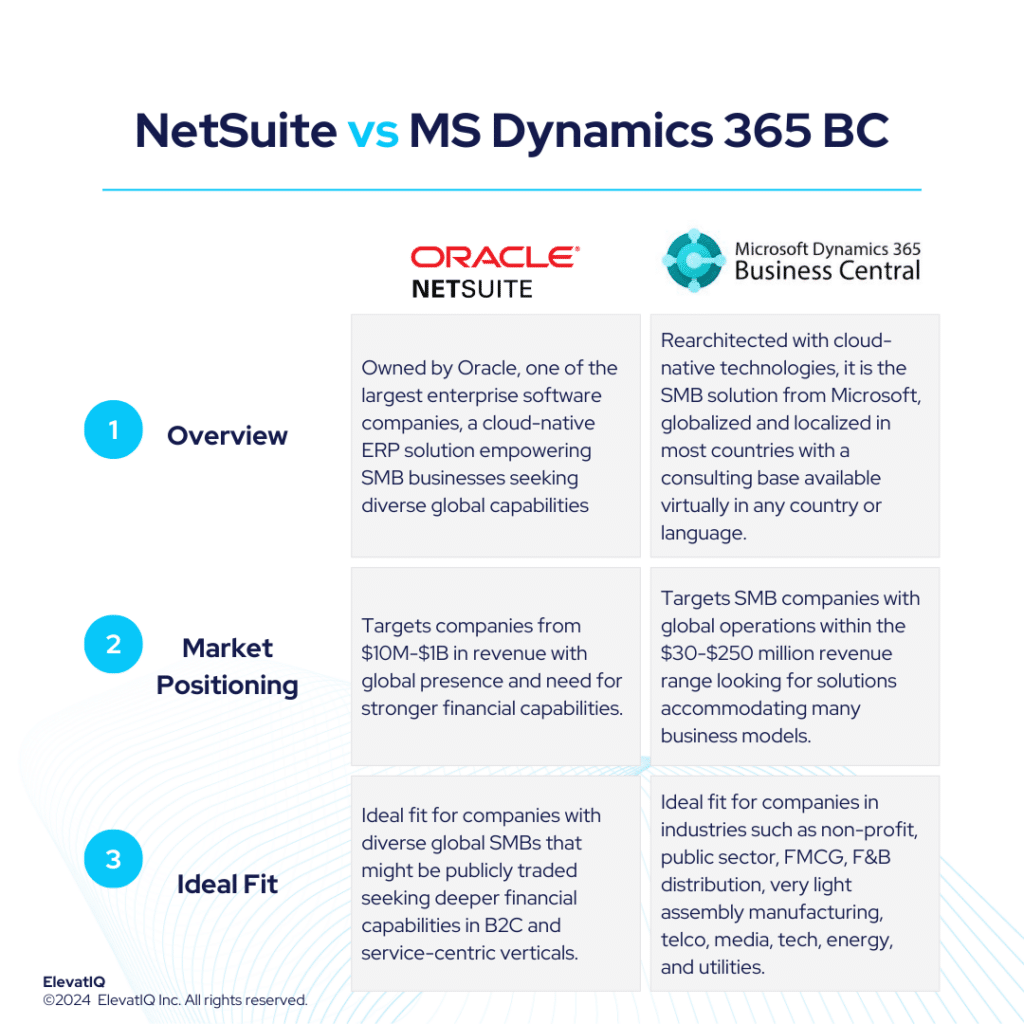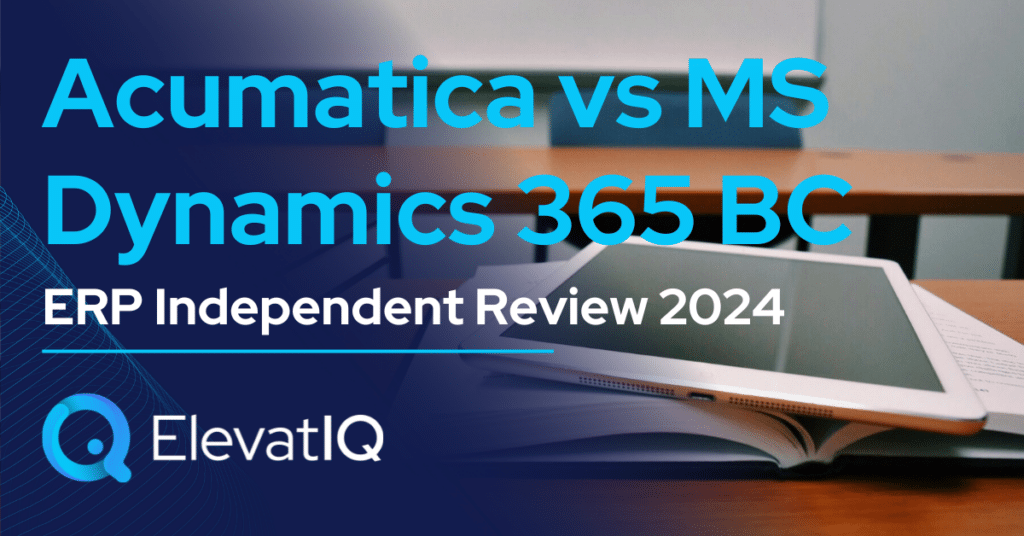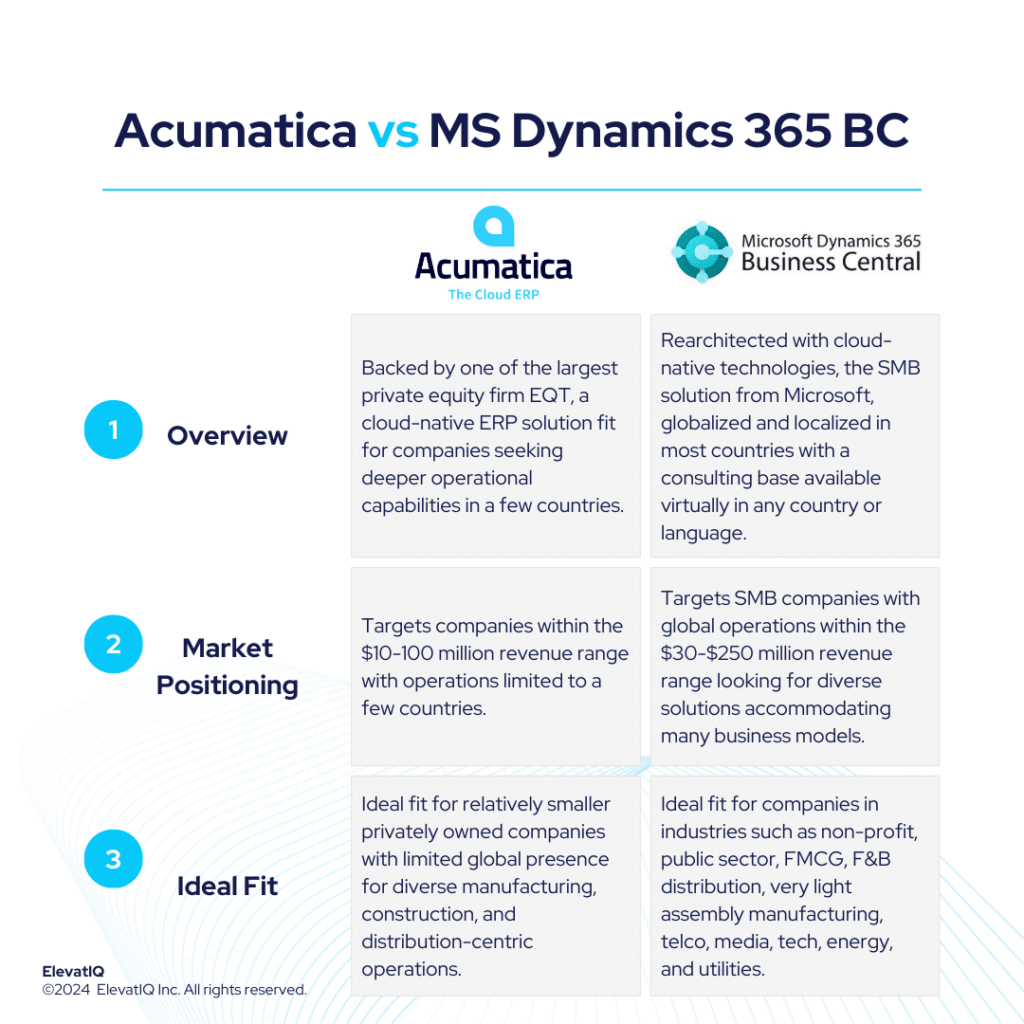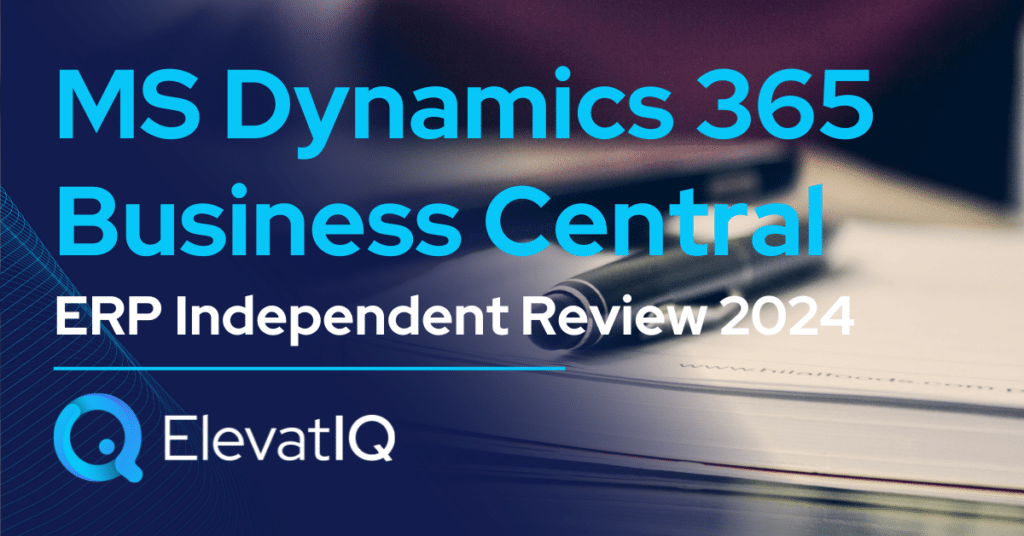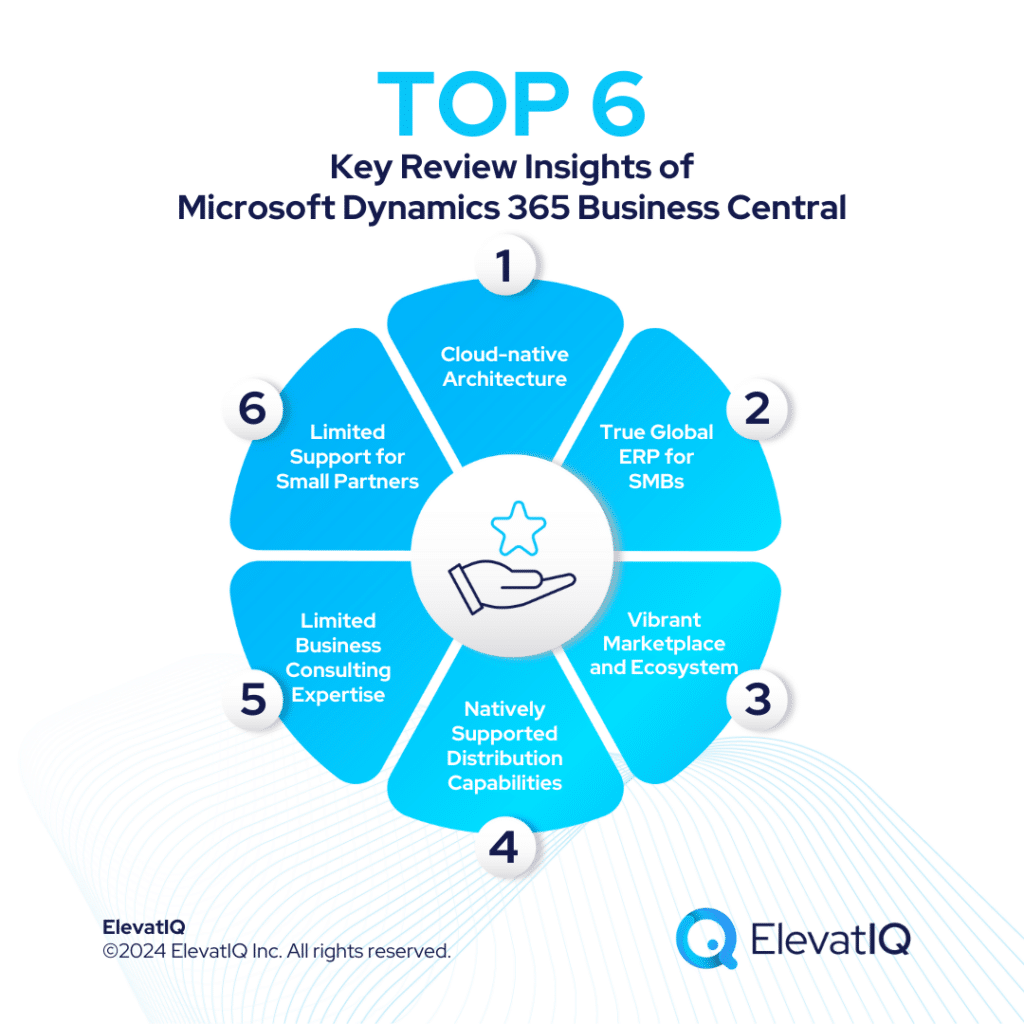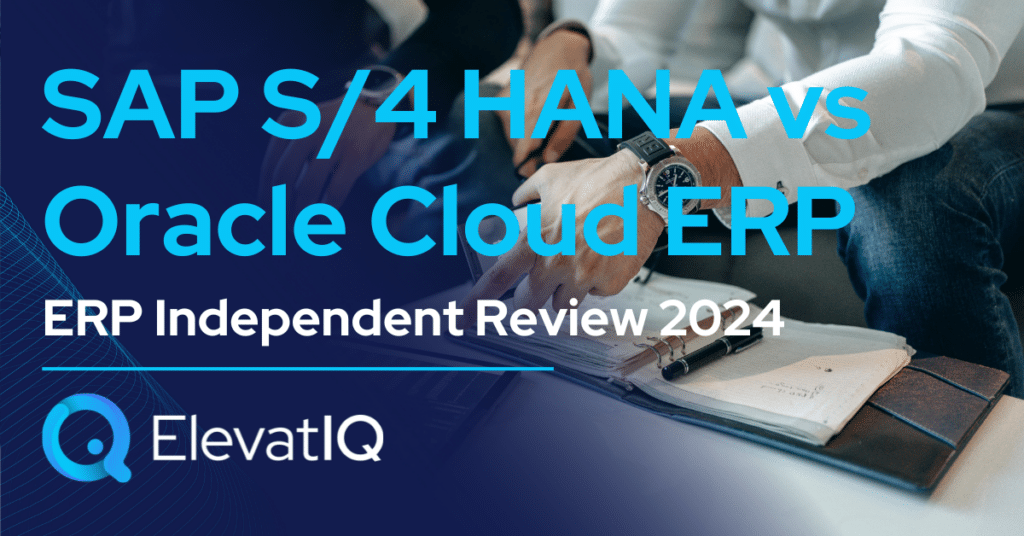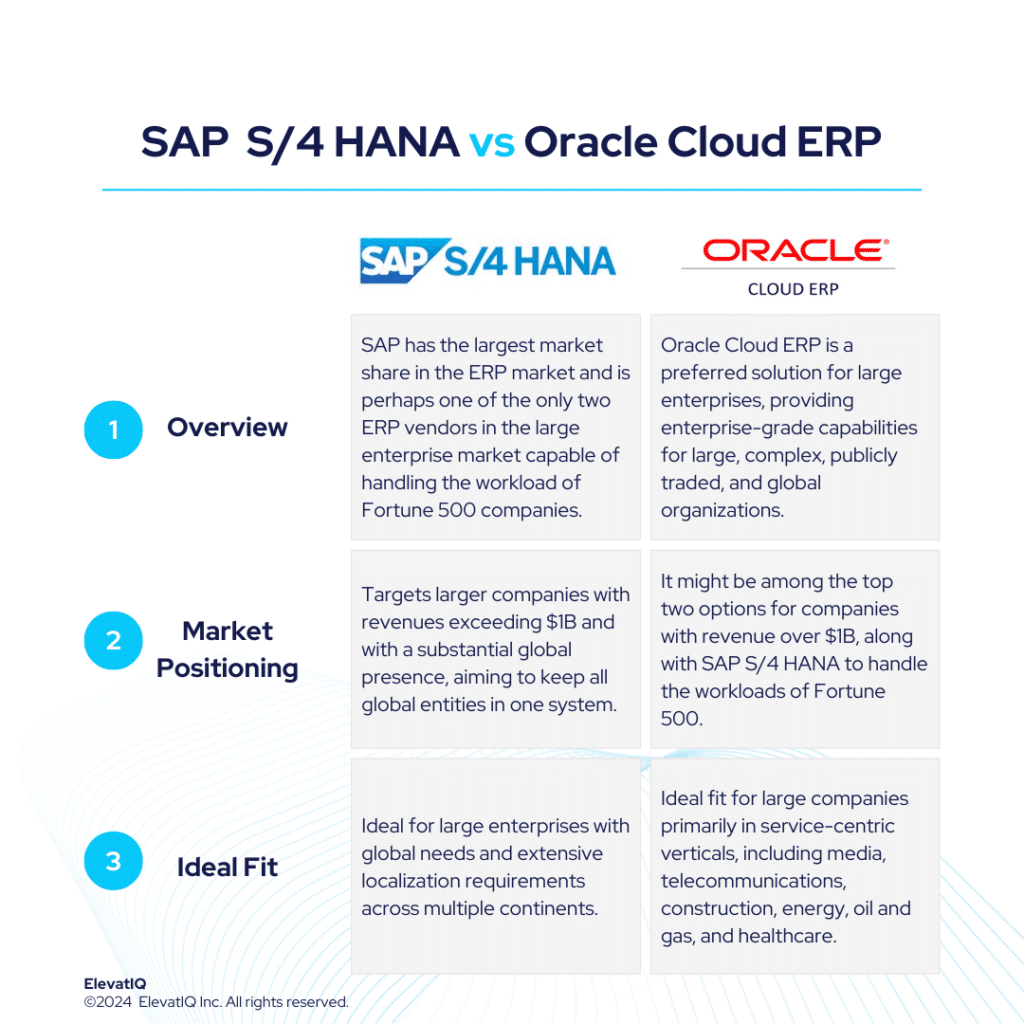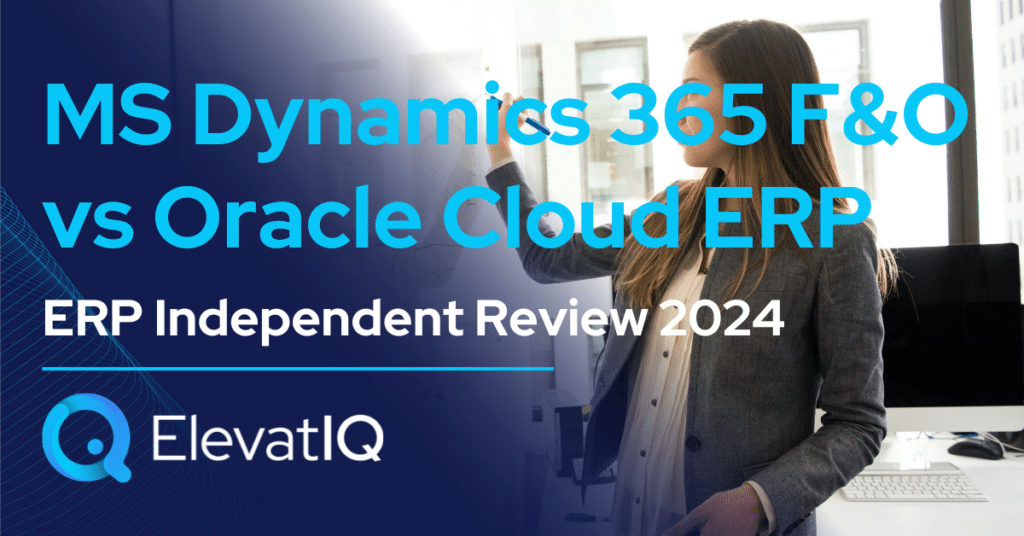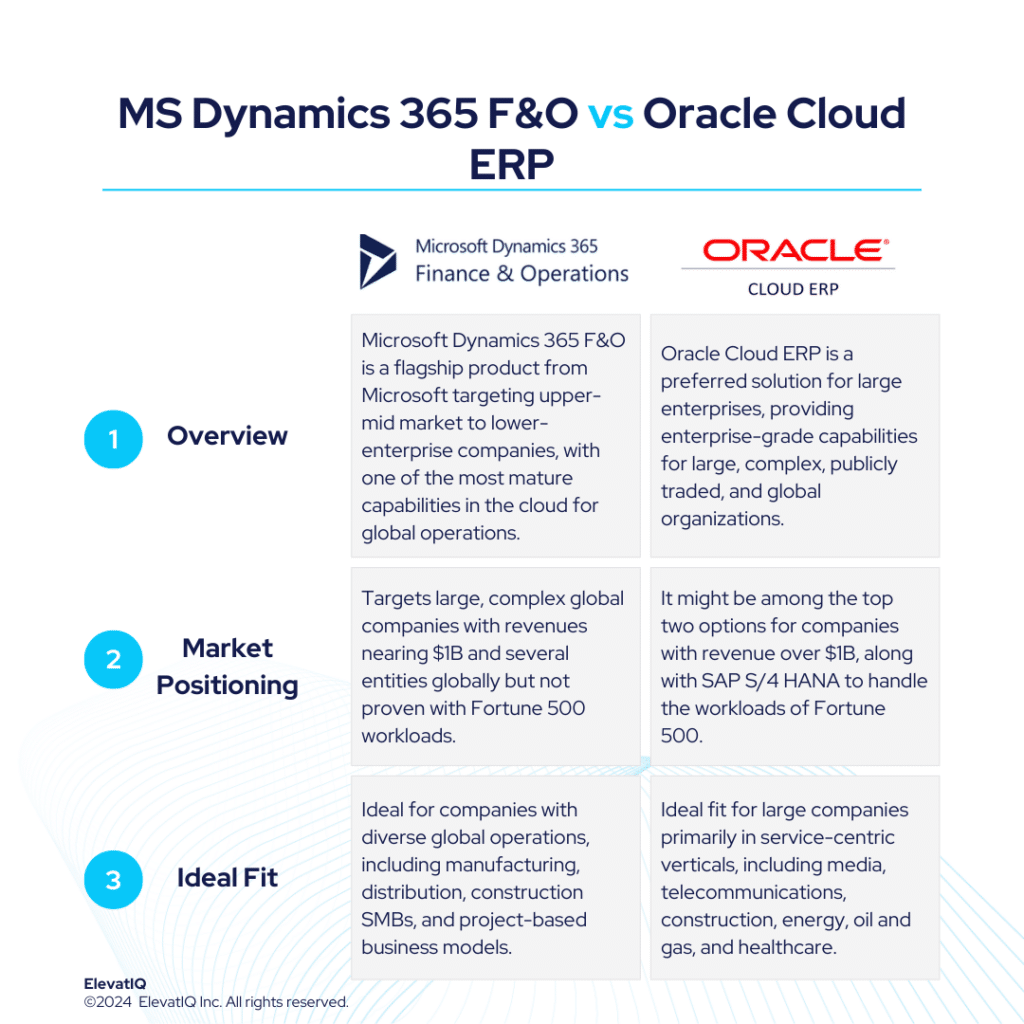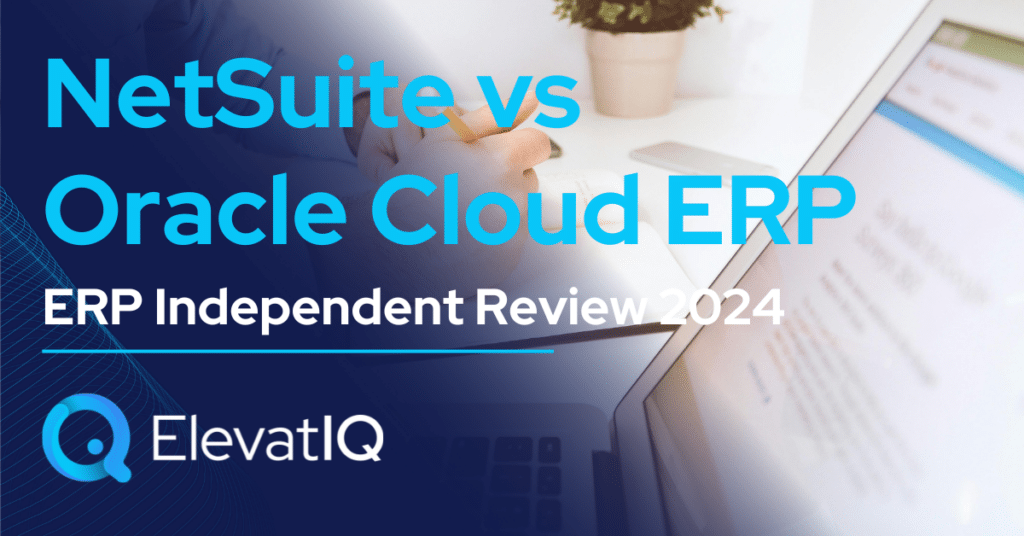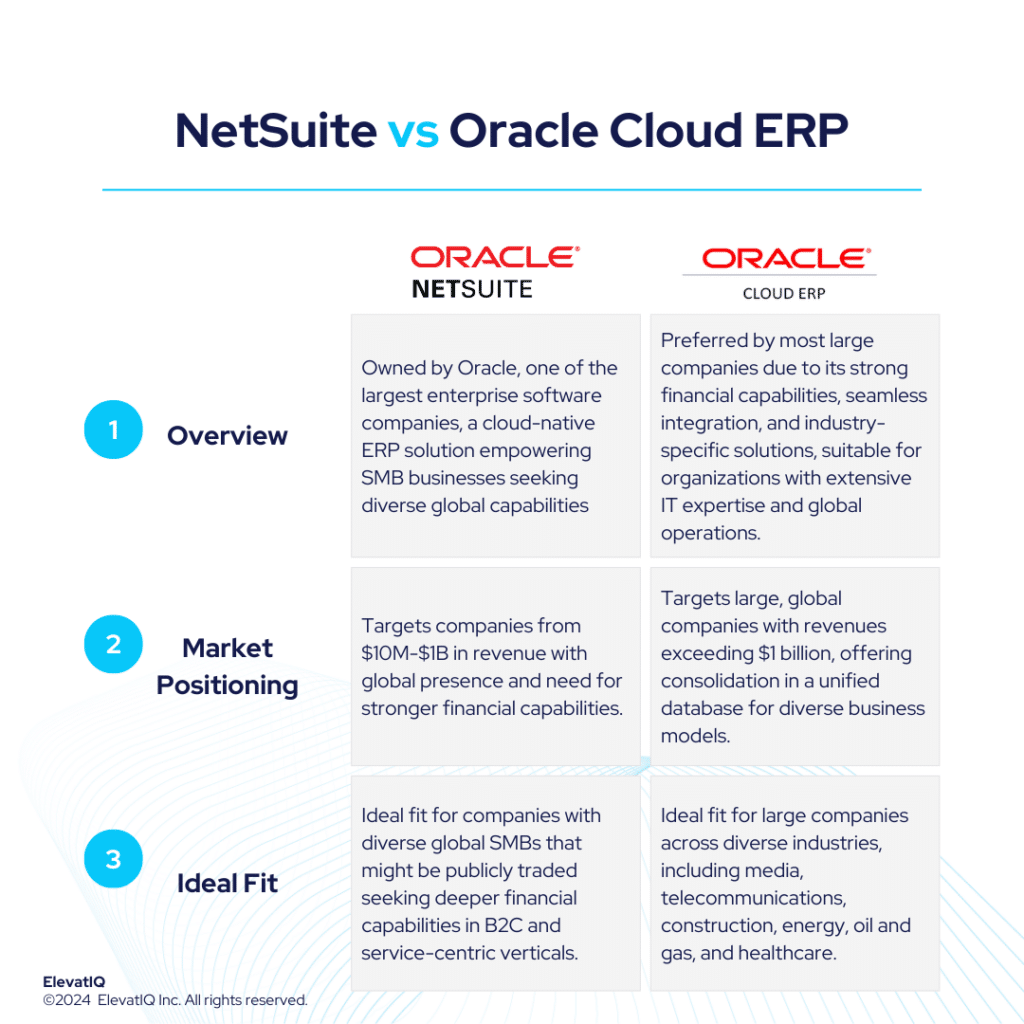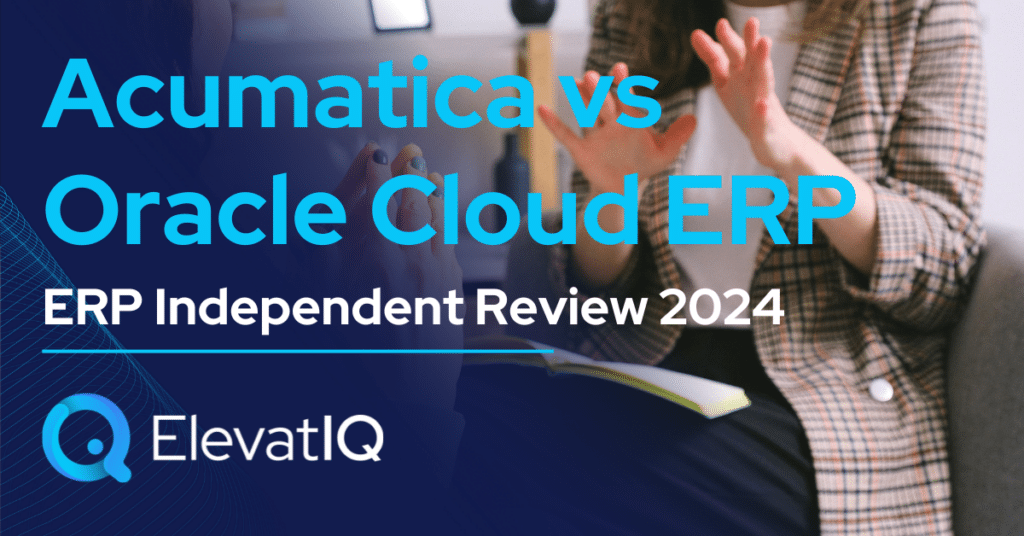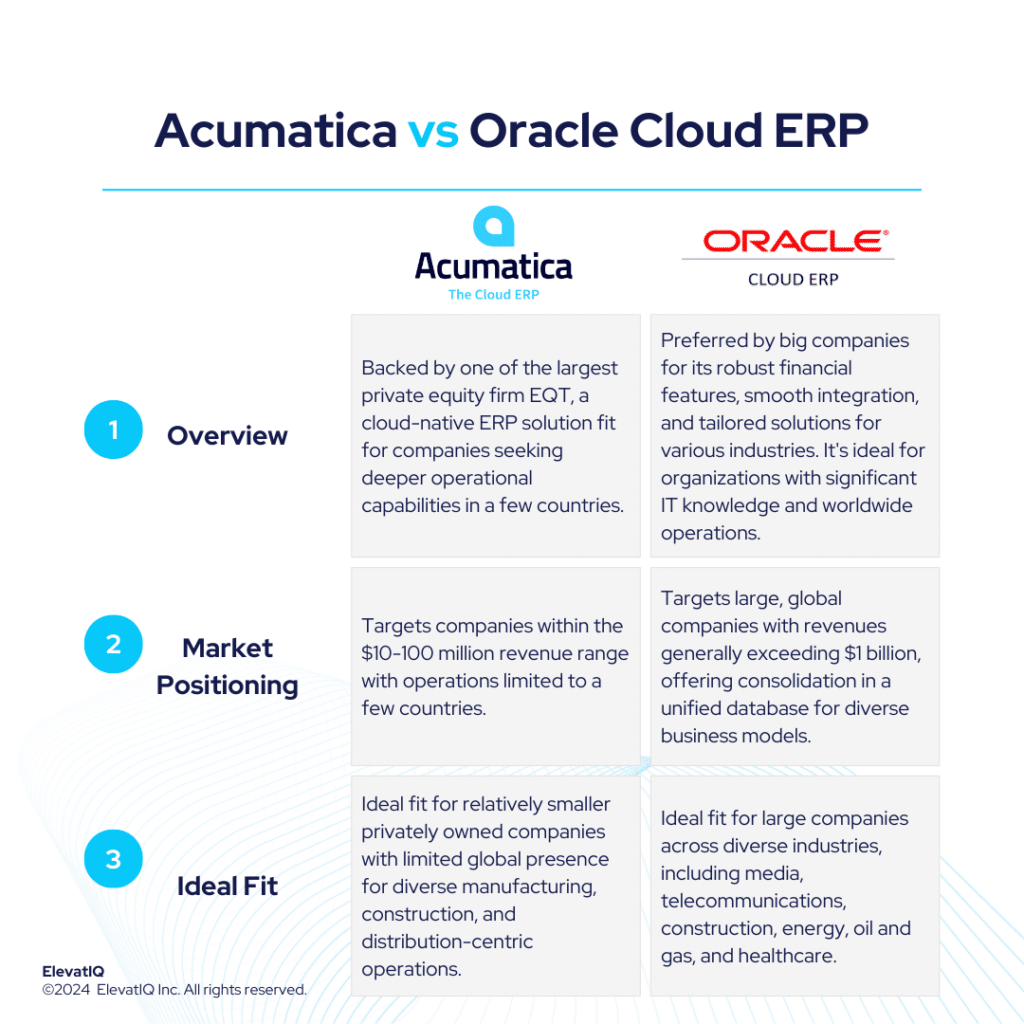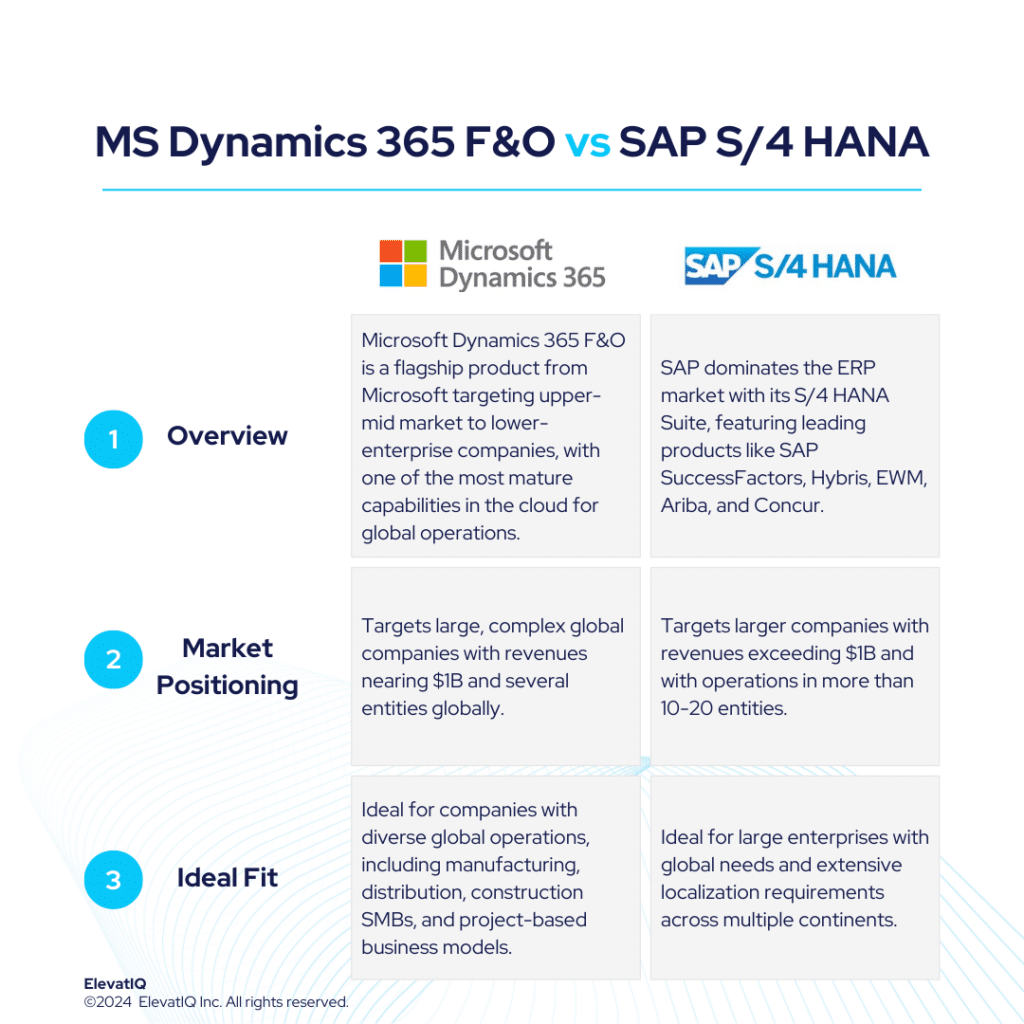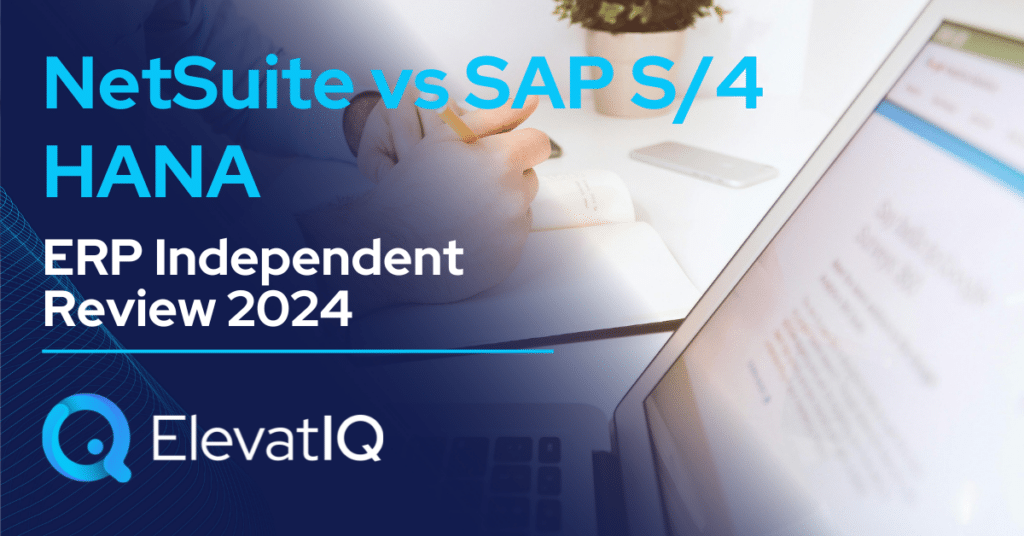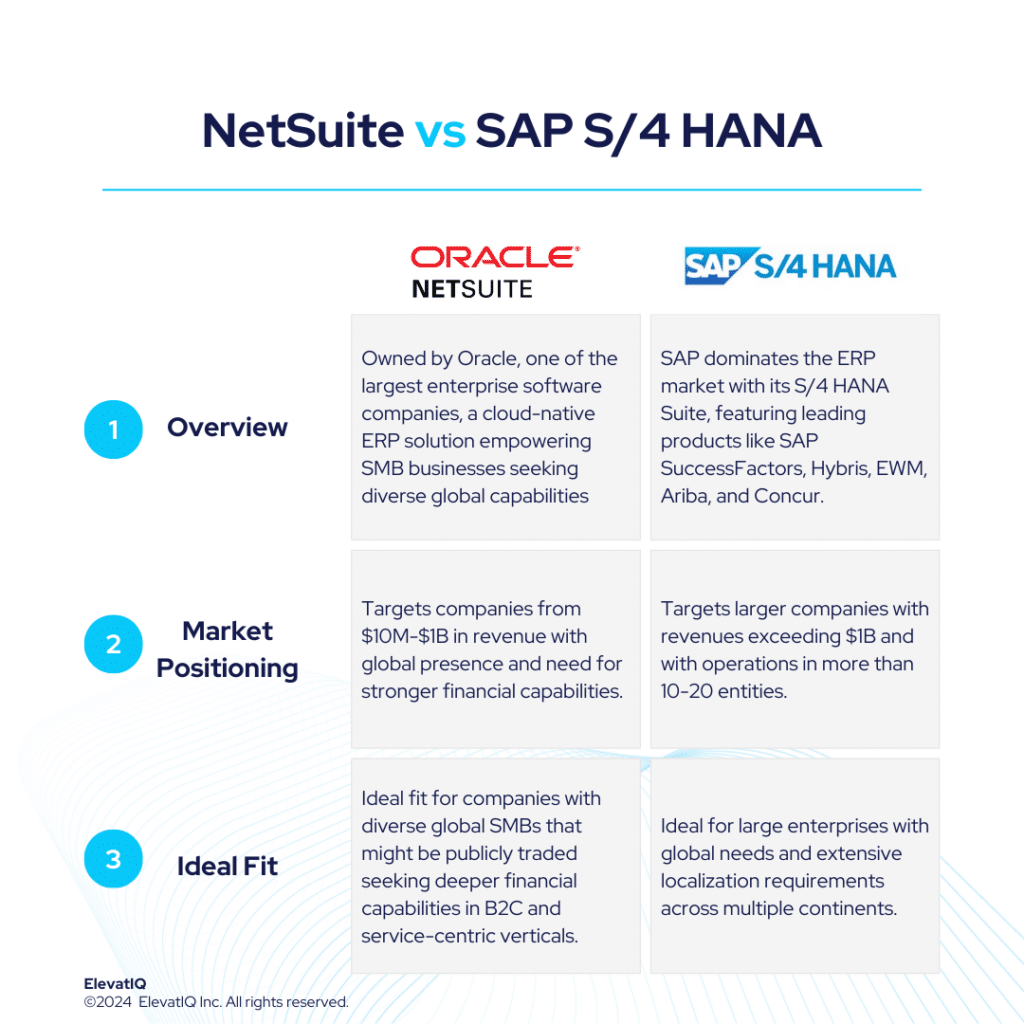MS Dynamics 365 F&O vs 365 BC ERP Independent Review 2024
Microsoft Dynamics 365 F&O stands out particularly for its enhanced cloud-native functionality, leading in capabilities over competitors like SAP S/4 HANA and Oracle Cloud ERP. It caters to large, global companies with complex business models, also offering mature technology and a successful track record across industries. On the other hand, Microsoft Dynamics 365 Business Central serves as a logical choice for companies outgrowing smaller ERP, MRP, and accounting systems like QuickBooks, Microsoft GP, Odoo, Katana, or Fulcrum.
Dynamics 365 F&O is ideal for companies particularly with diverse global entities, spanning industries like manufacturing, distribution, and construction. While, Microsoft Dynamics 365 Business Central is ideal for companies with diversified, global operations aspiring to keep all of their entities in one database for easier reconciliation and tracking. However, navigating the Dynamics 365 ecosystem may require assistance due to the presence of unqualified partners. Despite some technical issues, Dynamics 365 F&O remains a solid choice for companies of varying sizes and models. On the other hand, the biggest advantage of MS Dynamics 365 Business Central is its consulting ecosystem and community support, which is much bigger than most ERP ecosystems. Choosing between MS Dynamics 365 F&O vs 365 BC requires a detailed examination, and thus, this comparison offers valuable insights for ERP selection projects. So, let’s explore further.
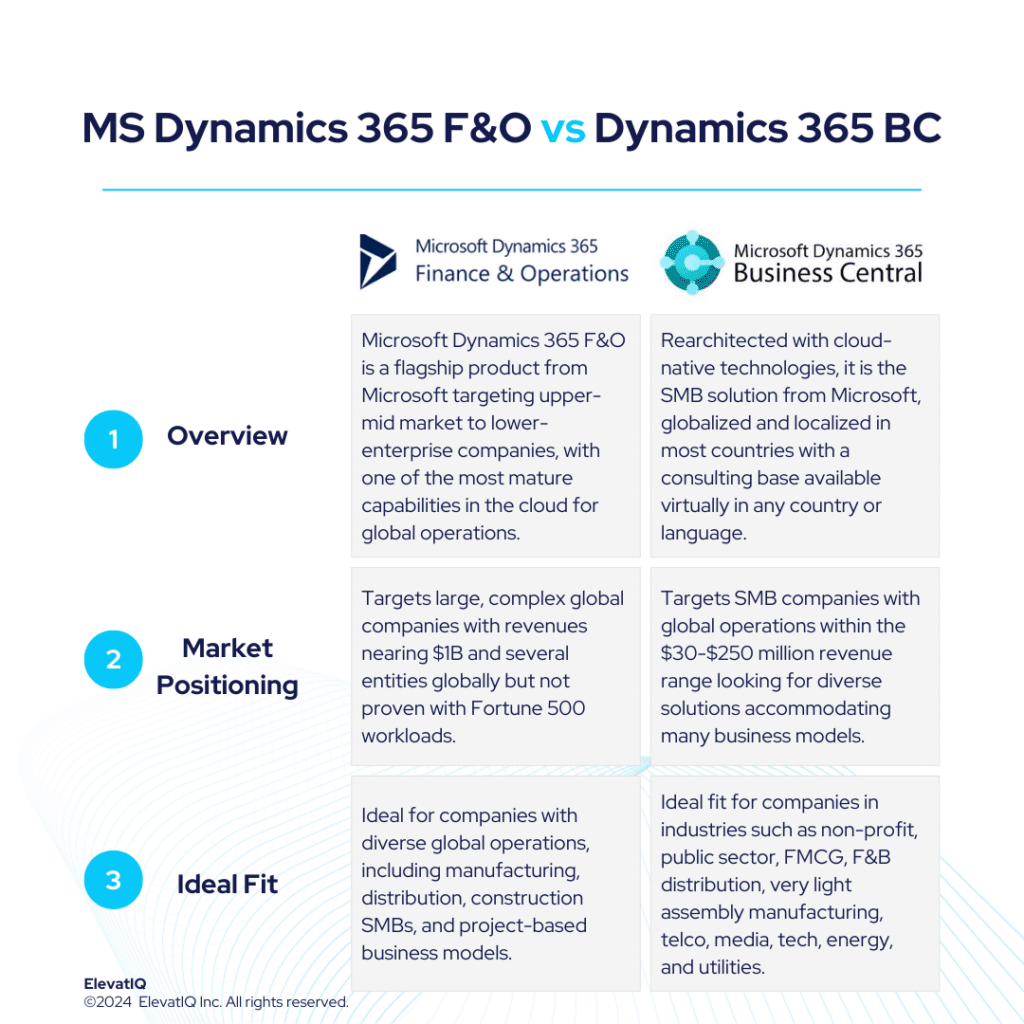

| MS Dynamics 365 F&O | MS Dynamics 365 Business Central | |
| Started in | Established enterprise software | 2018 (Previously NAV) |
| Ownership by | Microsoft | Microsoft |
| No. of customers | 50,000+ | 60,000+ |
What is Microsoft Dynamics 365 Finance & Operations (F&O)?
Microsoft Dynamics 365 F&O is often the third choice for larger global accounts, following SAP S/4 HANA and Oracle Cloud ERP. It also offers a mature ecosystem with modern, cloud-native technologies, proving successful across various industries. It is perhaps the most diverse solution accommodating several global business models in one database, making it an ideal solution particularly for lower enterprise companies. While a great fit as a corporate ledger for large enterprises, it’s not as proven as other leading solutions in the enterprise market with workloads as high as millions of journal entries per hour that Fortune 1000 companies might demand.
Microsoft Dynamics 365 F&O also excels in localizations where other solutions may falter. A vibrant ecosystem makes it suitable particularly for private equity and holding companies aiming to streamline their portfolio companies on one solution. SMBs, however, might find its complex data model overwhelming. Large, complex global companies with revenues exceeding $1B will also find Microsoft Dynamics 365 F&O appealing.
Although Microsoft Dynamics 365 Finance and Operations lacks the operational depth of specialized solutions, larger companies favor its corporate-level financial control. Furthermore, MS365 F&O offers seamless integration for field service, HCM, and CRM at the database level, empowering large companies to construct a best-of-breed architecture. It is especially strong with WBS-centric processes covering operational and financial schedules equally well. However, the challenge with MS Dynamics 365 F&O would be the best-of-breed ancillary systems critical for A&D systems, which are not owned and maintained by Microsoft, requiring third-party add-ons.
What Is Microsoft Dynamics 365 Business Central (BC)?
Rearchitected with cloud-native technologies, Microsoft Dynamics 365 Business Central is the SMB solution from Microsoft, globalized and also localized in most countries with a consulting base available virtually in any country or language. Microsoft Dynamics 365 Business Central serves as a logical choice for companies particularly outgrowing smaller ERP, MRP, and accounting systems like QuickBooks, Microsoft GP, Odoo, Katana, or Fulcrum. It is positioned against competitors such as Netsuite, Sage Intacct, and Acumatica. It also offers a vibrant ecosystem with numerous add-ons catering to industry-specific needs.
The sweet spot for MS BC would be $30M-$250 in revenue and a higher revenue band for companies that might use MS BC just for accounting and financial reporting while using mature operational systems at the subsidiary level. The biggest advantage of MS BC is its consulting ecosystem and community support, which is much bigger than most ERP ecosystems, and that’s why it’s probably one of the most popular solutions across geographies.
Microsoft Dynamics 365 Business Central is also ideal for companies with diversified, global operations aspiring to keep all of their entities in one database for easier reconciliation and tracking. While the add-ons might allow companies to use Microsoft Dynamics Business Central for complex industrial operations, the natural design and core would be compatible with companies in industries such as non-profit, public sector, FMCG, F&B distribution, very light assembly manufacturing, telco, media, tech, energy, and utilities.
MS Dynamics 365 F&O vs 365 BC Comparison
Navigating the choice between MS Dynamics 365 F&O vs MS Dynamics 365 BC is a significant decision for businesses particularly looking for operational efficiency and strategic alignment. Thus, this section delves into the comprehensive comparison review of MS Dynamics 365 F&O vs MS Dynamics 365 BC across various critical dimensions.
| MS Dynamics 365 F&O | MS Dynamics 365 BC | |
| Global Operational Capabilities | Consolidates multiple entities across different countries into one database. | Supported and actively installed in most countries globally. |
| Diverse Capabilities | Accommodates various business models but may need add-ons for specific industry functionalities. | Supports multiple industries and business models. |
| Best-of-breed Capabilities | Some crucial capabilities like PLM may require additional development. | Pre-integrated with Microsoft CRM and field service but relies on third-party add-ons for additional capabilities. |
| Last-mile Capabilities | May require add-ons for specific micro-verticals. | May require add-ons for specific micro-verticals. |
| Operational Functionalities | Provides rich operational functionality suitable for large enterprises. | Emphasizes core ERP capabilities, relying on partner add-ons for industry-specific capabilities. |
| Integration Capabilities | Pre-integrates with best-of-breed CRM and field service solutions, allowing siloed operation. | Common data model, power platform and automate along with MS Azure platform for additional development and integration. |
| Manufacturing Capabilities | Supports various manufacturing-centric models such as process, discrete, or batch. | Lighter manufacturing capabilities. |
| Pricing Model | Cost-per-user, per-month model with user flexibility and true consumption-based pricing. | Per named user, per month. True consumption-based licenses can be adjusted without long-term contracts. |
| Key Modules | 1. Financial Management 2. Supply Chain Management 3. Manufacturing Management 4. Human Capital Management 5. Business Intelligence and Reporting 6. Security and Compliance 7. Develop and Customize 8. System Administration | 1. Financial Management 2. CRM 3. Distribution Management 4. Supply Chain Management 5. Project Accounting Management 6. Inventory Management 7. Reporting, Dashboard and BI |
MS Dynamics 365 F&O vs 365 BC Feature Comparison
Both platforms offer a plethora of features and functionalities designed to streamline business operations and enhance efficiency. In this feature comparison, we delve into particularly the distinct capabilities of MS Dynamics 365 F&O vs 365 BC across various critical dimensions, providing insights to aid businesses in making informed decisions regarding their ERP selection. Thus, this section discusses features under each of the following modules, particularly financial management, supply chain management, manufacturing management, and business intelligence and reporting.
Financial Management Comparison
In this section, we are discussing a detailed comparison of the financial management capabilities particularly offered by MS Dynamics 365 F&O vs 365 BC. By examining their respective strengths and functionalities, particularly in managing financial processes businesses can therefore gain valuable insights to determine the best-suited ERP solution.
| MS Dynamics 365 F&O | MS Dynamics 365 BC | ||
| Financial Management | General Ledger | Creates and maintains accurate records for financial transactions and generates regular financial reports. | Initiates general ledger postings, chart of accounts, general journals, VAT facilities, recurring journals, and source codes. |
| Accounts Receivable and Accounts Payable | Automates workflows for managing vendor invoices, payments, and customer invoicing, streamlining the entire invoicing process and improving cash flow management. | Automates accounts receivables and payables and facilitates seamless reconciliation of accounts for swift and precise financial reporting. | |
| Cash Flow Management | Provides comprehensive cash flow forecasting capabilities, allowing to project future cash positions, identify potential shortfalls, and make informed decisions. | Provides comprehensive forecasting, analysis, and Azure ML-based prediction of cash inflows and outflows. | |
| Other Features | Chart of Accounts – Enables the creation of a hierarchical structure for categorizing financial information. | Currency Management – Manages multiple currencies across the system, including payables and receivables, general ledger reports, resource and inventory items, and bank accounts. | |
| Budgeting and Forecasting – Creates and manages budgets across different departments and business units. Also, leverages historical data and predictive analytics, to make accurate projections. | Tax Management – Offers automated, configurable, and scalable tax determination, calculation, and settlement capabilities, accommodating complex tax scenarios across various business requirements. |
Supply Chain Management Comparison
In this comparison, we explore and analyze the supply chain management capabilities of MS Dynamics 365 F&O vs 365 BC, shedding light, particularly on their respective strengths and weaknesses.
| MS Dynamics 365 F&O | MS Dynamics 365 BC | ||
| Supply Chain Management | Warehouse Management | Offers advanced features for warehouse and transportation management, ensuring efficient inventory tracking, order fulfillment, and logistics visibility. Supports complex models like 3PL and value-added services for warehouses. | Can be implemented in different complexity levels, depending on a company’s processes and order volume. The main difference is that activities are performed order-by-order in basic warehousing when they are consolidated for multiple orders in advanced warehousing. |
| Service Management | Manages service agreements, subscriptions, orders, inquiries, and service delivery analysis, particularly suited for global operations with extensive field workforce scheduling needs. | Service management is not built as part of the core platform but a pre-integrated specialized app is available for field service operations | |
| Inventory Management | Offers real-time inventory visibility, demand-supply optimization, and stockout reduction, catering to varied business models of complex organizations. | Ensures inventory availability by automatically computing stock levels, lead times, and reorder thresholds. Also, maintains optimal inventory levels by adjusting orders dynamically based on real-time inventory updates. | |
| Other Features | Procurement and Sourcing – Streamlines purchasing activities with end-to-end visibility, cost reduction, and improved supplier relationships. | Purchase Order Management – Manages purchase orders, including blanket orders and related processes. | |
| Transportation Management – Provides real-time logistics visibility. | Sales Order Management – Manages sales orders, including blanket sales orders and associated processes. | ||
| Demand Planning and Forecasting – Generates accurate forecasts to optimize production, inventory, and procurement. | Requisition Management – Organizes complex distribution processes involving multiple products and suppliers. |
Manufacturing Management Comparison
In this comparison, we explore and analyze the manufacturing management ERP capabilities of MS Dynamics 365 F&O vs 365 BC, shedding light, particularly on their respective strengths and weaknesses.
| MS Dynamics 365 F&O | MS Dynamics 365 BC | ||
| Manufacturing Management | Production Planning | Provides comprehensive production planning and control capabilities, allowing organizations to optimize their manufacturing processes. The system supports various production scenarios, including make-to-order, make-to-stock, and engineer-to-order, while providing real-time visibility into production schedules, resource allocation, and material requirements. | Enables the creation of production orders, definition of routings, allocation of resources, and optimization of production sequences, ensuring seamless operations. |
| Other Features | Shop Floor Management – Offers real-time monitoring of shop floor activities, capturing data on machine utilization, labor productivity, and production progress. | BOM and Routing – Allows for the detailed mapping of production processes, including the components, subassemblies, and resources used, as well as the sequence of operations. | |
| Product Lifecycle Management – Enables organizations to manage the entire product lifecycle, from design and engineering to manufacturing and after-sales service. The system integrates product data, engineering change orders, and quality management processes, ensuring seamless collaboration and visibility across different departments. | Advanced Planning and Scheduling – Takes into account all demand and supply data, nets the results, and creates suggestions for balancing the supply to meet the demand, ensuring optimized resource utilization and efficient production control. |
Business Intelligence and Reporting Comparison
In this comparison, we explore and analyze the business intelligence and reporting capabilities of MS Dynamics 365 F&O vs 365 BC, shedding light, particularly on their respective strengths and weaknesses.
| MS Dynamics 365 F&O | MS Dynamics 365 BC | ||
| Business Intelligence and Reporting | Real-time Analytics and Dashboard | Enables organizations to gain real-time insights into their operations with interactive dashboards and reports. Also, provides visual representations of key performance indicators, financial metrics, and operational data, empowering stakeholders to make data-driven decisions. | Provides real-time visibility into overall support performance, allowing supervisors to monitor key operational metrics, make course corrections at the right time, and keep service levels high |
| Reporting | Creates custom reports and visualizations tailored to specific needs. This flexibility enables in-depth analysis, data exploration, and the generation of actionable insights to drive continuous improvement and strategic decision-making. | Provides an improved reporting and dashboard system that makes it easier to find and run the reports you need, and to analyze your data. |
Pros of MS Dynamics 365 F&O vs 365 BC
When evaluating ERP solutions, understanding the distinct advantages of MS Dynamics 365 F&O vs 365 BC is crucial. In this section, we are particularly exploring the strengths of MS Dynamics 365 F&O vs 365 BC across various dimensions. Thus, shedding light on their respective capabilities and functionalities.
| MS Dynamics 365 F&O | MS Dynamics 365 BC |
| Has a significant advantage in its extensive consulting base and a vibrant marketplace, a unique benefit unmatched by many ERP systems. | Natively supports global regions and localizations where Acumatica, Epicor, or Infor might have limited support. |
| Supports global operations and business models and pre-baked integration for the best-of-breed CRM and field service solutions. | Unlike several products such as Acumatica, it has support for several European, Asian, and African countries where most products might struggle. |
| Embedded WMS and TMS processes help companies that might require end-to-end traceability even after the good leaves the dock. | The data model is friendlier for FMCG and distribution companies requiring native support for complex features such as bin tracking or license plate support. |
| Legacy product rearchitected for the cloud. So, while better than other legacy products that might be behind in the cloud. May not have a superior user experience. | The product has been completely rearchitected using the cloud-native architecture. Cloud ERP capabilities are stronger than those of competing products. |
Cons of MS Dynamics 365 F&O vs 365 BC
Just like recognizing strengths is important, it’s also crucial to weigh the specific drawbacks of MS Dynamics 365 F&O vs 365 BC. Therefore, in this section, we will delve into the limitations and challenges associated with MS Dynamics 365 F&O vs 365 BC across various operational and financial dimensions.
| MS Dynamics 365 F&O | MS Dynamics 365 BC |
| Smaller companies may find the configuration and approval flows designed for large enterprises overwhelming. | Only fit for FMCG-centric distributors. The industrial distribution would require add-ons to support capabilities. |
| Performance may not meet expectations for large, complex organizations processing millions of journal entries per hour. | While the ecosystem may have options for distribution industries, it might not have integrations with the best-of-breed eCommerce systems in the industrial distribution space. |
| Overbloated financial control processes, such as compliance, allocation, and approval flows. | The financial traceability may not be as intuitive for global, publicly traded non-profit companies. |
| Navigating the Microsoft Dynamics 365 ecosystem might require assistance due to the presence of unqualified ISVs and VARs. | The data layers are highly detailed, requiring substantial consulting help to be successful. |
| Integration with A&D-specific PLMs, configurators, and CPQ systems is not out-of-the-box, leading to increased implementation time and costs. | Microsoft doesn’t offer any support or control to its smaller products, leading to ERP implementation issues. |
| Implementing last-mile capabilities for specific A&D verticals may necessitate third-party solutions or custom integration, increasing expenses. | While Microsoft Dynamics 365 BC has a vibrant marketplace to augment its core capabilities, the last-mile capabilities required for manufacturing or industrial distribution might be limited. |
Conclusion
In conclusion, the comparison between MS Dynamics 365 F&O vs 365 BC reveals distinct strengths and ideal use cases for each platform. Dynamics 365 F&O emerges as a robust solution tailored particularly for large, global enterprises with complex business models, offering advanced functionalities and seamless integration across diverse operations. Its extensive consulting base and vibrant marketplace also make it a compelling choice for companies seeking a comprehensive ERP solution. However, smaller companies may find its configuration overwhelming, and certain industry-specific integrations may require additional development or third-party ERP add-ons.
On the other hand, Dynamics 365 BC presents itself as an ideal solution for SMBs and mid-sized enterprises looking to streamline their operations and transition from legacy ERP systems. Its user-friendly interface, coupled with a wide range of consulting support and community resources, makes it a popular choice across various industries. While Dynamics 365 BC may lack some of the advanced capabilities of F&O, its flexibility and scalability make it well-suited for companies with global operations seeking a cost-effective ERP solution. Ultimately, the decision between MS Dynamics 365 F&O vs 365 BC depends on the specific needs and priorities of each organization, highlighting the importance of thorough evaluation and consideration of key factors before making a selection. Hence, seeking assistance from an independent ERP consultant can significantly aid the decision-making process, offering specialized advice and direction tailored to the specific needs of the business.

FAQs
MS Dynamics 365 F&O vs 365 BC ERP Independent Review 2024 Read More »

